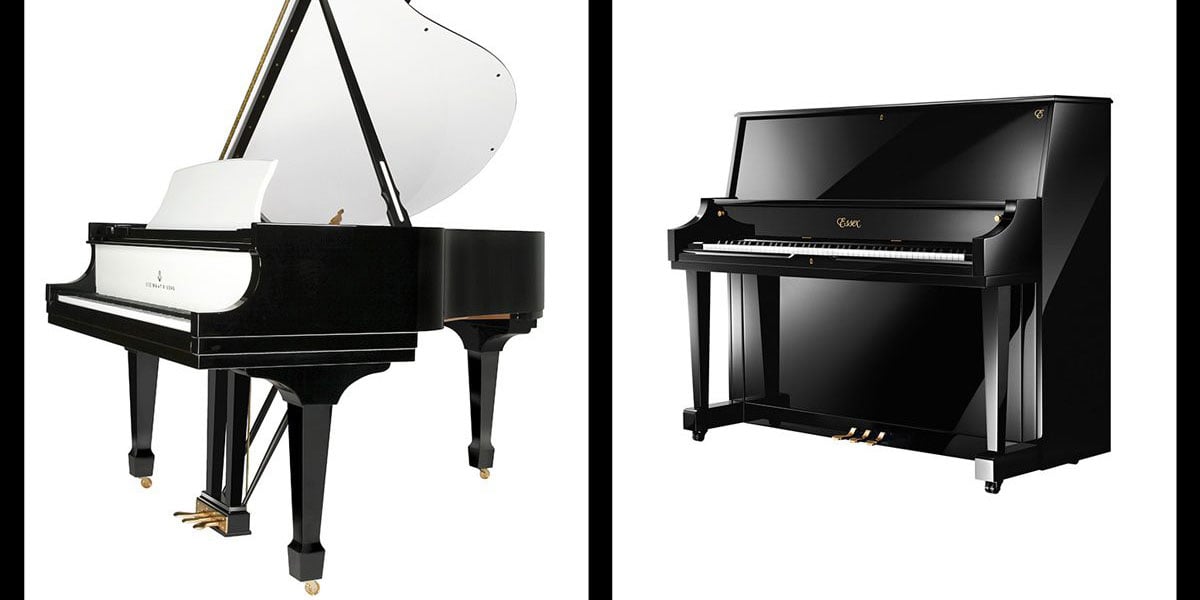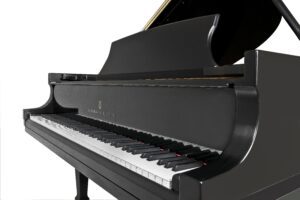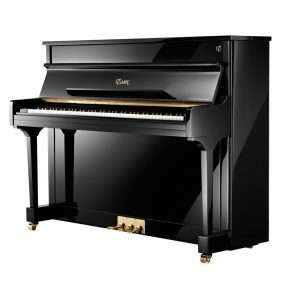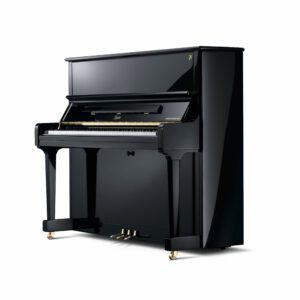What are the main differences between a grand piano and an upright?
April 26, 2022 •Stephen Reed

Both grand pianos and uprights can be exceptional instruments, but some significant differences exist, both in terms of design and style.
 When we think of the term “piano,” we usually think of the grand piano, like this model from the Steinway Victorian model from their Heirloom Collection.
When we think of the term “piano,” we usually think of the grand piano, like this model from the Steinway Victorian model from their Heirloom Collection.By the end of this article, you will know the main differences between these two types of pianos, helping you to determine which kind of piano is best for you. Knowing these differences is important so that you don’t make the mistake of a poorly-informed piano purchase, one that disappoints you soon after you bring it home.
| Major Differences Summary | Grands | Uprights |
|---|---|---|
How measured |
Horizontal - Keys to tail length |
Vertical - Floor to top of cabinet |
Action |
Gravity Reset |
Spring Assist |
Pedals |
3 - Including Full Sostenuto |
2 or 3, typically not Full Sostenuto |
Sound Projection |
Controlled and targeted through lid |
Smaller reach |
Grand pianos: Measured by length
 All grand pianos, regardless of length, are about 5 feet in width.
All grand pianos, regardless of length, are about 5 feet in width.Grand pianos are measured by the length from the front edge of the keys to the tail end. Their measurements are:
- Baby grand: Up to 5’7” in length
- Medium grand: 5’7” to 5’10” in length
- Full grand: 5’10” to 7’ in length
- Performance grand: 7’ to 9’ in length
- Concert grand: 9’ and above in length
All grand pianos, regardless of length, are about 5 feet in width.
General features of all grand pianos as compared to uprights
Grand pianos have a fuller resonance, more nuanced tonality, and a broader dynamic range than uprights. The combination of these features allows pianists to express themselves fully. Additional advantages of the grand piano over uprights include:
- Wider dynamics from pianissimo to fortissimo
- Sound is more uniform and well-balanced
- Smoother sustain
- More nuanced note expression
These features combine to allow a pianist to infuse more emotional expression than is possible with an upright piano.
The grand piano’s responsive action: Gravity reset
 Once a grand piano's key releases, gravity naturally resets the hammer and the damper. This natural reaction makes for a more responsive action than that in the upright piano.
Once a grand piano's key releases, gravity naturally resets the hammer and the damper. This natural reaction makes for a more responsive action than that in the upright piano.One key aspect to grand pianos is their exceptional action. All grand pianos utilize gravity to return the hammer to rest. The action and strings are placed horizontally into the piano case.. When a key is pressed, the hammer strikes the piano string vertically.
Once a key releases, gravity naturally resets the hammer and the damper. This natural reaction makes for a more responsive action than that in the upright piano. The action on the grand piano responds faster, as it is reacting naturally to gravity.
This rectifies the inherent problem with upright pianos, to be discussed later in this article. Gravity reset offers more control of dynamics, repetition speed, and overall piano tone.
Upright pianos: Measured by height
 The Essex Upright Model EUP-111E. No matter the height, upright pianos take up the same floor space of roughly five feet by two feet.
The Essex Upright Model EUP-111E. No matter the height, upright pianos take up the same floor space of roughly five feet by two feet.Uprights are compact pianos that remain popular due to their smaller footprint. Uprights have brought high-level music to millions of middle-class homes over the years, to families who could not afford a grand piano.
Sometimes called vertical pianos, they are named this because the strings and soundboard are positioned vertically, perpendicular to the floor.
Uprights come in several height variations, all of which have a unique sound. No matter the height, upright pianos take up the same floor space of roughly five feet by two feet. Upright height sizes are:
- Spinet: approx. 36” high
- Console: approx 40-44” high
- Studio: approx 44-48” high
- Professional: approx. 48” high and above
Spinets used to be a popular option for home use, but these days, manufacturers produce more studio or console uprights as the smallest option.
The upright's spring action
Uprights do not have the advantage of gravity and utilize a spring action to allow the hammer to rest. When a key is pressed, a mechanism causes the hammer to strike the string horizontally.
Once the key is released the hammer is enabled to reset thanks to a built-in spring. Here’s the issue in terms of action responsiveness in the upright: before one can restrike the key, it has to raise a particular distance to reset the spring.
Uprights generally do not have the rich tonality of grands, as a sensitive action is more difficult to produce when hammers move sideways instead of upwards against gravity. Nevertheless, newer uprights are doing better on this score.
Differences in the piano pedals
In addition to the actions, another significant difference between uprights and grands is in the piano pedals.
For example, the left pedal on the grand, called the “soft pedal” or “una corda pedal,” shifts the entire action to the right. This softens the volume but also makes nuanced changes to the piano’s tone. The left pedal on the upright simply moves the hammers closer to the strings, making the volume softer but not affecting the instrument’s tone.
The middle pedal, known as the sostenuto pedal on the grand, raises the dampers, keeping them away from the strings, allowing for select notes to be sustained. But in the upright, the middle pedal is known as the muffler pedal. When pressed, a think piece of felt is placed between the hammers and strings, muting the sound.
The right pedal is known as the sustain or damper pedal in both the grand and the upright. In both pianos, the right or sustain pedal, also known as the damper pedal keeps dampers lifted even after the key is released, sustaining all notes that have been played.
When is an upright preferable to a grand piano?
 Boston Upright UP-126-E Performance Edition. Depending on the buyer's needs, particularly in terms of available space in their home, a quality upright can be the obvious choice for smaller rooms.
Boston Upright UP-126-E Performance Edition. Depending on the buyer's needs, particularly in terms of available space in their home, a quality upright can be the obvious choice for smaller rooms.With differences ranging from greater resonance, a more responsive action, and greater sustain in the pedals, one may well wonder if an upright can ever be preferable to a grand piano.
While grand pianos have traditionally been seen as the superior instrument versus the upright, exceptions can be found. A quality, new upright will certainly outperform an old, spent grand. One can always find quality uprights that are more expensive than lower-quality brands. Materials and craftsmanship can always make a difference between pianos.
In short, a high-quality upright piano will outperform and outlast a poorly made, inexpensive grand piano.
Moreover, depending on the buyer's needs, particularly in terms of available space in their home, a quality upright can be the obvious choice for smaller rooms.
Sampling a range of uprights and grands is key to your decision
Especially if your budget is in the area of high quality uprights and smaller grands, a visit to different piano stores, featuring various brands and models of uprights and grands.
Only by testing a range of uprights and grands can you find the piano that is best for you. You may find that a quality upright meets all your needs, from tone to smaller size. Or you might find that a stretch up to a baby or medium grand piano is worth the further investment.
Spending time with a seasoned piano consultant like those at M. Steinert & Sons can help you narrow down your best options, based on your budget. Making an appointment to visit one of our showrooms will give you time to sample enough uprights and grands to be a much more-informed piano buyer.
In the meantime, learn more about uprights and the smaller grands by reading the following articles:
Featured Articles
Categories
- Beginner Pianos (18)
- Boston Pianos (12)
- Comparisons (26)
- Designer and Specialty Pianos (8)
- Essex Pianos (10)
- Events (11)
- Featured (21)
- Institutional (3)
- Joy of Piano (12)
- Learning About Pianos (62)
- News (34)
- Piano Bits (6)
- Pricing and Cost (19)
- Resource Center (116)
- Roland Pianos (6)
- Spirio (13)
- Steinway Pianos (64)
- Student (14)
- Teacher (12)
- Used Pianos (20)
- Videos (13)

